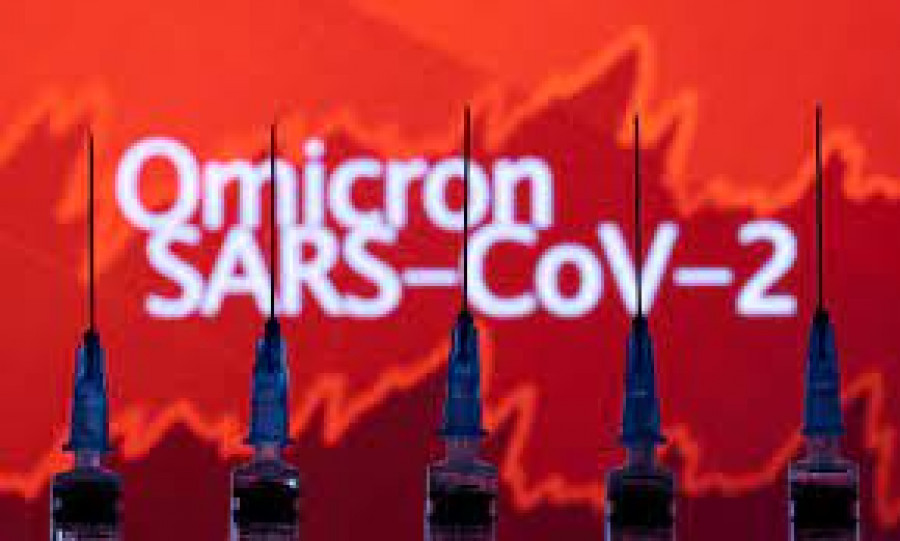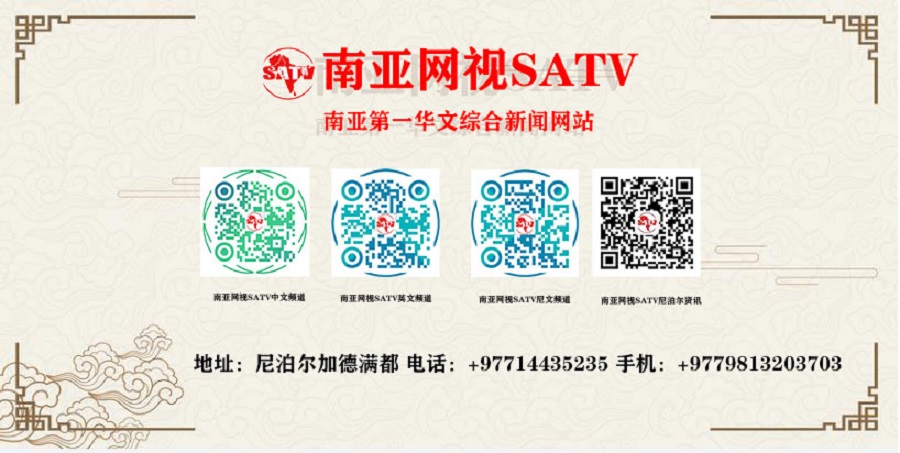
Even as countries throughout the world have been raising alarms over the spread of Omicron, a new lineage of SARS-CoV-2—B.1.1.529 that causes Covid-19, authorities in Nepal are yet to decide on the preventive measures to tackle the threat.
Cases of the new variant, which has been designated as “variant of concern” by the World Health Organisation, have already been reported in over 40 countries.
But the Nepal government has decided to ban the entry of passengers arriving or transiting only from nine countries—South Africa, Botswana, Zimbabwe, Namibia, Lesotho, Eswatini, Mozambique, Malawi, and Hong Kong so far.
Experts stress additional preventative measures including strict enforcement of the Covid-19 safety measures, wider coverage of the vaccination drives, setting up of quarantine, isolation and holding centres, and adding hospital beds, among others.
Many countries around the globe have sped up their vaccination drives while some have decided to give booster shots despite researchers still studying the effectiveness of the existing vaccines against the new variant.
Virologists, as well as epidemiologists in Nepal, have also called for expansion of the vaccination drives as they believe that the currently available vaccines offer some level of protection against the virus.
Here is what you need to know about Nepal’s vaccination status.
How many people have been vaccinated so far?
As of December 5, altogether 10,352,845 people (34.1 percent) have taken their first dose of the vaccine and of them, 8,697,989 people (28.8 percent) have received their second dose as well.
The vaccines used so far are AstraZeneca vaccine (manufactured in India, Japan, and Europe); Vero Cell, developed by China’s Sinopharm; Janssen by US-based Johnson and Johnson; and Pfizer-BioNTech vaccine, which was also developed in the US.
How many doses have Nepal received so far and from where?
As of December 3, the country has received 25,049,840 doses of Covid-19 vaccines—Vero Cell, AstraZeneca, Janssen, Pfizer-BioNTech and Moderna.
Nepal launched its vaccination campaign on January 27 2021 with the 1 million doses of Covishield received in grant assistance from India. Covishield is the AstraZeneca type vaccine manufactured by the Serum Institute of India.
In the first week of March, COVAX, an international vaccine-sharing scheme backed by the United Nations, supplied 348,000 doses of Covishield. At the end of March, 800,000 doses of Vero Cell were brought in from China, which Beijing had provided under grant assistance. An additional 1 million doses of Vero Cell under Chinese grant arrived again in June.
China donated an additional 1.6 million doses of the Vero Cell vaccine on November 3.
Apart from this, the Chinese Army and the Chinese Red Cross Society supplied 300,000 doses and 100,000 doses of Vero Cell vaccine to the Nepal Army and Nepal Red Cross Society respectively.
Doses given to the Nepal Red Cross Society were handed over to the Ministry of Health and Population.
Nepal Army used the jabs on its personnel and their dependents.
On March 28, the Indian Army had also provided 100,000 doses of Covishield to the Nepal Army. The doses were used to vaccinate Army personnel and their dependents.
On July 12, a little over 1.5 million doses of the single-shot Johnson & Johnson vaccine (Janssen) landed in Kathmandu. The vaccine was provided by the United States through COVAX.
On August 6, the government of Bhutan delivered 230,000 doses of the AstraZeneca vaccine to Nepal.
On August 7 and 8, Japan shipped 513,420 doses and 333,900 doses, respectively, to Nepal as part of its commitment to providing 1.6 million doses through COVAX. Then on August 21, as many as 208,060 doses were supplied to Nepal. Two days later, the remaining 559,360 doses were also delivered.
The Maldives supplied 201,600 doses of the AstraZeneca vaccine in October; Switzerland supplied 492,000 doses of the same vaccine in November. Canada also supplied 368,000 doses of the AstraZeneca vaccine in November and Denmark supplied 492,000 doses of the same.
Apart from this, the United States supplied 100,620 doses of the Pfizer-BioNTech Covid-19 vaccine through the COVAX. The facility has also supplied 188,400 doses of the Moderna vaccine.
Most of the said countries supplied the jabs through the COVAX facility.
How many doses have Nepal bought and how many more to arrive?
The government in February signed a deal with the Serum Institute of India to buy 2 million doses of Covishield. In the same month, the Serum Institute supplied 1 million doses but stopped shipment of additional doses, citing the coronavirus crisis in India. The remaining 1 million doses were supplied in October.
From China, Nepal has purchased 10 million doses of the Vero Cell vaccine under a non-disclosure agreement.
The government has also purchased 5,936,400 doses of Vero Cell under the COVAX facility’s cost-sharing scheme, with the loan provided by the Asian Development Bank. Of the 5,936,400 doses, the facility has already delivered 2,078,000 doses. A consignment of the remaining doses is likely to arrive within December.
Nepal has also signed concessional loan agreements with multilateral funding agencies like the Asian Development Bank and the World Bank as part of their support to Nepal’s resilient recovery from the Covid-19 pandemic.
In August, the Asian Development Bank and the Nepal government signed a $165 million (nearly Rs20 billion) loan agreement to purchase vaccines against Covid-19.
The government has also purchased an additional 500,000 doses of the Vero Cell vaccine through the COVAX’s cost-sharing scheme using the Asian Development Bank’s loan. The doses are scheduled to arrive within the first quarter of 2022.
Authorities have also purchased 4 million doses of Moderna vaccine from the Asian Development Bank’s loan, also through COVAX’s cost-sharing scheme. The doses are expected to be delivered within the first quarter of 2022.
Moreover, the government has bought 6 million doses of Pfizer-BioNTech vaccine from the US using the World Bank’s loan.
Officials claim over 34 million doses of different types of vaccines will arrive in the country within two months. Of the over 34 million doses that Nepal is set to receive, some the government has purchased and others will be provided by COVAX.
According to officials, COVAX, the international vaccine-sharing scheme backed by the United Nations, will supply 2,188,800 doses of single-shot Janssen, 3,712,000 doses of Moderna vaccine, of which 188400 doses have been delivered, and 3,364,000 doses of AstraZeneca.
All the said doses are scheduled to arrive by December this year.
Additionally, the COVAX facility is also providing 6,039,000 doses of AstraZeneca and this shipment is also expected within December.
China is providing 3 million doses of the Sinovac vaccine which is scheduled to arrive within this month.
How many doses have been administered so far?
According to data provided by the Health Ministry, 19,050,834 doses have been administered so far (both first and second doses). Officials estimate that around five percent of the doses might have gone to waste. They said that the government has around 5 million doses in stock in various storage facilities throughout the country.
What is the country’s current Covid-19 status?
With 205 additional people testing positive on Sunday—200 in 7,995 polymerase chain reaction tests and five in 2,752 antigen tests, the number of people infected with Covid-19 reached 918,184.
In the last 24 hours, only one death has been recorded from the coronavirus infection. Active cases stand at 6,507 throughout the country as of December 6.
The Covid-19 death toll stands at 11,541.
Are the existing Covid-19 vaccines effective against the Omicron variant?
Although not much is known about the latest variant, the World Health Organisation said that researchers are still conducting studies to see if the existing vaccines are effective against the new variant of the virus or not.
Virologists and epidemiologists in Nepal are also of the opinion that the available vaccines offer some level of protection and suggest authorities ramp up the vaccination drives.
“Even if the existing vaccines may not give 100 percent protection against the new variant, I think they definitely provide some level of protection,” Dr Sher Bahadur Pun, chief of Clinical Research Unit at the Sukraraj Tropical and Infectious Disease Hospital, told the Post.
“People used to say that the existing vaccines are not effective against the Delta variant also, but our own experience shows that the vaccines saved hundreds of lives,” he said.
“When compared, unvaccinated people reported severe symptoms of the virus infection and in some cases even resulting in death than those who got the jabs,” said Pun who is also a virologist.
Is vaccination still relevant?
Doctors say, yes. With many countries including the United States starting to provide booster shots, experts in Nepal also call for the need to speed up the vaccination drives.
“Authorities should speed up the vaccination drive,” said Dr Biraj Karmacharya, an epidemiologist, who is also the Head of the Community Programme at the Dhulikhel Hospital. “Authorities should target people who have not yet been vaccinated. They are at risk of contracting the virus and suffering from severe symptoms,” he said.
How many people does Nepal need to vaccinate?
Around 78 percent of the 30 million population–or around 25 million people–need to be vaccinated, in line with the government’s new plan to vaccinate those aged between 12 and 14. The government had earlier planned to vaccinate only those above 14 years.
Only 28.8 percent of the total population has been fully immunised with Covid-19 vaccines, and authorities have to still administer jabs to around 50 percent of the population above 12 years old.













